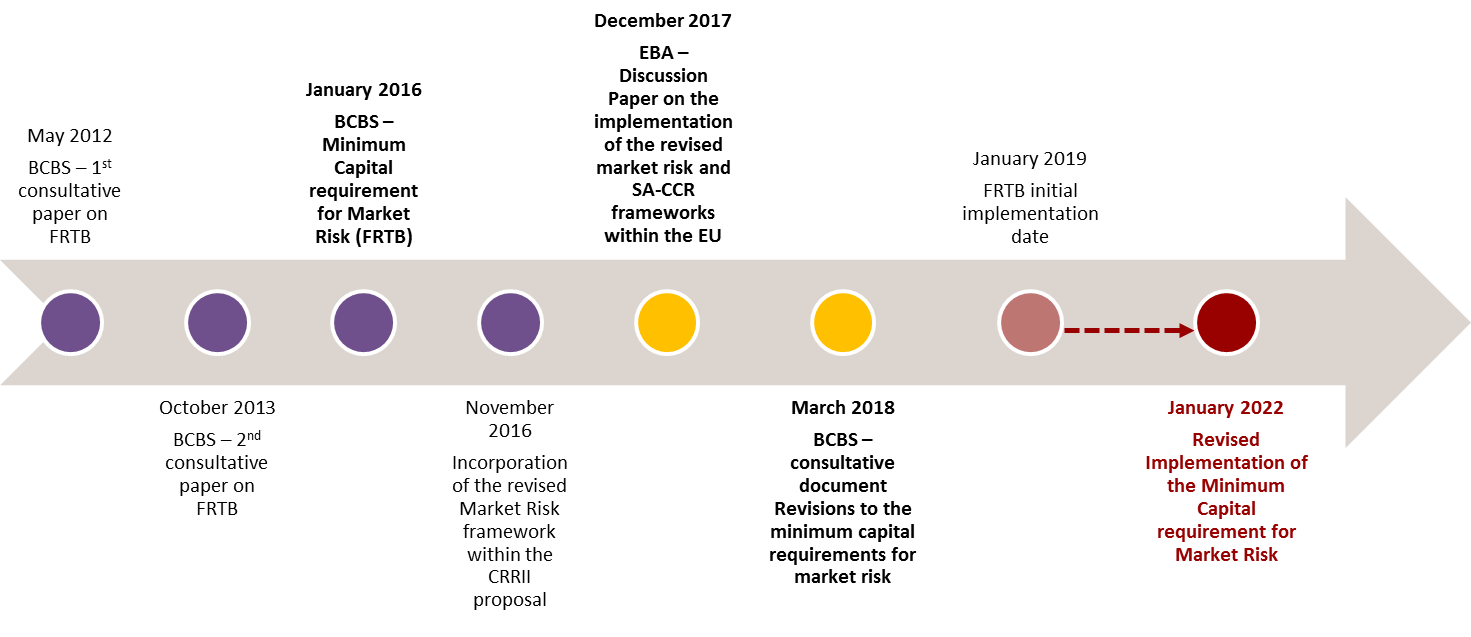FRTB: has the journey finally begun or has it just ended?
Perspectives
FRTB: has the journey finally begun or has it just ended?
Tue 27 Mar 2018
It is truly amazing the turmoil 88 pages can produce. Yet while the whole Banking Industry is strongly opposed to some of the new Fundamental Review of the Trading Book (FRTB) requirements, such as the Profit & Loss Attribution (PLA) test, could the EU Council now be considering to only include reporting requirements in CRR2?
As a reminder of how we got here, in January 2016 following five years of consultation, the Basel Committee on Banking Supervision (BCBS) issued the revised minimum capital requirements for market risk, the so-called FRTB. FRTB aims to harmonise capital standards for market risks across jurisdictions and to prevent significantly undercapitalised trading book exposures through five key enhancements:
1. A revised Trading/Banking book boundary
2. A revised Internal Models Approach (IMA) approval process (P&L attribution and back testing).
3. A revised Standardised Approach (SA) with a sensitivity-based methodology and a new role in determining the IMA floor.
4. New market risk measures (Expected Shortfall, Default Risk Charge).
5. More stringent requirements in terms of policies, procedures and reporting.
However, since the revised standards have been incorporated in the CRR2 proposal they have raised so many questions that, in December 2017, the Basel Committee decided to postpone its implementation from January 2019 to January 2022.
Then the EBA ran a Discussion Paper (DP) on the implementation of the revised market risk and SA-CCR frameworks within the EU from December 2017 to 18th March 2018.
Through this DP, the EBA launched the “discussion” on subjects within its CRR2 proposed mandates so that the corresponding Implementation and Regulatory Technical Standards (ITS and RTS respectively) could be issued shortly after the revised CRR approval.
However, among six main topics open to discussion there was one subject against which the whole industry fiercely opposed: the Profit & Loss Attribution (PLA) test.
Together with Back Testing (BT), PLA is part of the IMA approval process to be performed at the individual trading desk level. These tests aim to assess whether a model produces reliable capital requirements and consist of a periodic comparison of the bank’s daily risk measures (ES or VaR) with the subsequent daily profit or loss (“trading outcome”). In order for the IMA to be authorised, both tests must be satisfied on an ongoing basis.
The problem is that the EBA does not deal with the nature of PLA, which is the very grounds for criticism, nor with sensible questions such as XVA hedges. The discussion paper focuses on clarifying the definition of P&Ls used in P&L Attribution metrics (risk theoretical P&L and hypothetical P&L). The International Swaps and Derivatives Association (ISDA) and the Association of Financial Markets in Europe (AFME) published the Banking Industry response mid-March making it clear that there is disagreement on PLA proposals.
Notably, the Industry does not agree with the definitions proposed, particularly on the valuation adjustments treatment. According to the Industry, even though those adjustments are key, they have no place in the Hypothetical P&L and more broadly in the PLA test which has been designed to assess the model performance and not the capital adequacy, unlike BT. So, while including those valuation adjustments at top level in BT – as proposed by the EBA – makes senses, clarification is first required on a number of things including the type of XVAs within the Market Risk scope, as well as the inclusion of IMA approved and non-IMA approved desks in the actual P&L.
Recently, on 22nd March 2018, the Basel Committee issued its consultative document “Revisions to the minimum capital requirements for market risk”. It includes a number of changes related to the standardized approach – including a simplified alternative to it – the internal approach and the scope of market risk capital requirements.
Overall, the proposed design for PLA test metrics is aligned with the EBA’s proposal, it is therefore expected that the Banking Industry will not fully agree with the Hypothetical P&L or Risk-Theoritical P&L definitions.
However, for the first time, the Basel Committee proposes a traffic light approach based on “zones” – green, amber, red – determined according to the trading desks’ PLA test performance. The objective of such an approach is to avoid a cliff effect for those of the trading desk that fell short of the PLA requirements. Those desks “that have not performed so poorly” will be able to keep using the IMA but will be subject to a capital add-on.
This traffic light approach should address the Industry’s concern about the future of internal models.
While expectations were that both the EBA’s DP and the Basel’s consultative documents were a step towards FRTB implementation, recent news reports2 suggest that the EU Council is thinking about postponing its effective implementation and only include reporting requirements in CRR2, leaving the rest to CRR3. Another option, according to the report, would be to include a “light” version of the Basel Standards in the CRR2 package until the Basel paper is finalised.
Since 2016, the Banking Industry has never stopped asking for clarification and even modification. This has not been easy when both the Basel Committee and the European Banking Authority (EBA) both seem to be taking charge of the effective implementation of the revised standards. At the same time, banks have launched “FRTB projects” that have required a lot of resources – both financial and human. FRTB has forced banks to rethink their trading strategy, to change their organisation and to review their whole IT architecture. While the DP felt like a tiny step towards clarification and implementation, the latest news regarding another postponement of FRTB definitely sets the cat among the pigeons.
- Industry Response to EBA RTS Discussion Paper on Market Risk & Counterparty Credit Risk framework
- https://www.risk.net/regulation/5460826/european-frtb-capital-charges-hang-by-a-thread
Want to get notified when new blog posts are published?
Subscribe
